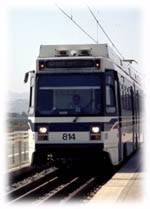| |
  |
|
|
First Of A Series By Karen
Walz Introduction
To some students of urban issues, the intersection between these two images of our future lies in our past -- in new towns that evoke the 1920's as surely as the 1990's. While these communities do meet the needs of some future residents, they are not the best indicator of the future of our cities. Our big, post-World War II cities are. The experience of these cities offers an enticing look at some of the factors that are critical if we are to create livable 21st century cities. America's "Postwar Cities" What is a "postwar city" and why are these cities important? A postwar city is one that has experienced most of its growth since World War II. According to 1998 U.S. Census Bureau figures, sixteen of America's 30 largest cities have added more than half of their population since 1940. They are:
The reasons for examining these cities include their impact (current and future), the factors most critical to their development (which relate to their age), and the lessons they offer to other communities. Census Bureau statistics are again enlightening. They show that nearly eighty percent of all Americans live in metropolitan areas, and 11.7% of us live in these cities or their surrounding primary metropolitan areas. In fact, almost 6% of all Americans in 1998 lived in one of these sixteen cities. The impact of these cities' futures on our nation is itself significant. To the extent that their experience suggests a trend followed in their suburban communities or in smaller metropolitan areas with similar characteristics, the impact is even greater. In addition, many of these cities may well be our major 21st century cities, if the past century is any indication. Despite the dramatic changes of the past 100 years, 13 of the cities that were in the top 30 in 1900 are still in the top 30 in 1998! The age of these cities makes
them most relevant to the set of choices available to communities today
and in the near future. Compared to the other major American cities,
they are quite young. Only three of them (Los Angeles, Columbus and
Memphis) had more than 100,000 residents in 1900. As noted above, most
of their growth has taken place after World War II. Unlike older cities,
these communities' growth has been shaped by factors very much in What's Happening in these Cities? Like the cotton and apricots that preceded some of them, they're sun-grown. For the most part, these cities are located in the Sunbelt regions of the southeast and west. With one notable exception (Memphis), they have experienced continuing population growth in every decade since 1940. The choices they offer appear desirable to people who can "vote with their feet" as well as those who have more limited options. As these cities continue to accommodate more residents, they are balancing the competing demands of creating new development and maintaining or reinvesting in existing neighborhoods and business areas that may be 20 to 40 years old. For many of these cities, this balance is expressed in neighborhood-oriented programs, an emphasis on parks and green spaces that link communities together and reinvestment in downtowns and brownfields. Several, including Houston and Columbus, have innovative neighborhood planning and investment programs. All but two (Nashville and San Jose) are participating in EPA's Brownfields Program. Managing this new growth while maintaining "middle-aged" parts of the community is a challenge for all of these cities, and an issue that will face their suburbs and other newer communities during the 21st century. Almost all of these cities are addressing urban issues in a regional setting that requires cooperation or collaboration with other jurisdictions. Though all of these cities are the largest in their metropolitan areas, twelve of them are home to less than 60% of their region's population. They are using a wide variety of approaches to solve problems, mostly voluntary and focused on one or a few specific issues, but few of them have the luxury of a monolithic decision-making process. Collaboration and partnership are essential to their success. The residents of these cities
are diverse. For half of them, over 20% of the 1990 population was black.
For 9 of the 16, Hispanics made up more than 20% of the 1990 population.
Other ethnic groups also play an important role in a number of these cities.
These diverse residents bring a wide range of traditions and cultures
to their communities; they also must interact with one another on a regular
basis.
"The
average density for these new major cities is 2,683 persons per
square mile, far less dense than today's large older cities." These postwar cities are less dense than the major cities of the last century. Of these cities, Los Angeles had the highest population density in 1990 at 7,427 persons per square mile (compared to San Francisco at 15,502 persons per square mile and New York City at 23,705 persons per square mile). The average density for these new major cities is 2,683 persons per square mile, far less dense than today's large older cities (the average density for the other cities in the top 30 was 9,236 persons per acre in 1990). This density pattern reflects the factors that were influential during these cities' development. It also reflects many households' decision-making preferences in recent decades, preferences that may well be shared by many of our 21st century cities' residents. Despite these lower densities
and their automobile heritages, alternative transportation modes are
an increasingly important part of these cities. Of the other twelve cities, two have trolley systems serving parts of their communities. At least six others are reportedly considering light rail systems today, with at least three in serious evaluation. Transit systems, with bike and pedestrian networks, are increasingly viewed as valuable parts of livable communities. A Model for Sustainability These major cities of the postwar era suggest the strategies that will create a livable and sustainable city for the 21st century as well as the challenges a livable city must address.
By reshaping neighborhoods and business areas to meet changing market demands, cities can maintain their own health and desirability. In the process, they reduce some of their regions' pressure for outward expansion, potentially retaining open space or agriculture, reducing commutes and regional costs for infrastructure and public services. The 21st century cities that result may be sustainable in two senses: as desirable places to live and as communities that use proportionately fewer non-renewable resources. The history and current policies of these major postwar cities give us the best examples to use in designing livable cities for the future. Next In Livable Cities Of The 21st Century The second article in this series will detail some of the successful programs and practices in these leading American cities. Karen
S. Walz is the Principal in Strategic Community Solutions (SCS)
and the Executive Director of The Dallas Plan, a non-profit organization
created to work with the city of Dallas and the Dallas community to
create and implement a long range plan. Prior to forming SCS, Walz was
Director of Planning for Freilich, Leitner and Carlisle, managing planning
projects for clients nationwide. She has also served as the Manager
of Comprehensive Planning for the City of Austin and as Special Assistant
for Economic Policy at the Boston Redevelopment Authority. |
|
Home | History & Archive | Video Productions & Services © Copyright 1998-2023 EcoIQ
|













 ivability.
Smart growth. Sustainability. These are some of the phrases politicians,
urban planners, developers and others use when describing the future
of American communities. The words used by residents are more direct:
safe, clean, affordable, friendly, with good jobs.
ivability.
Smart growth. Sustainability. These are some of the phrases politicians,
urban planners, developers and others use when describing the future
of American communities. The words used by residents are more direct:
safe, clean, affordable, friendly, with good jobs.

